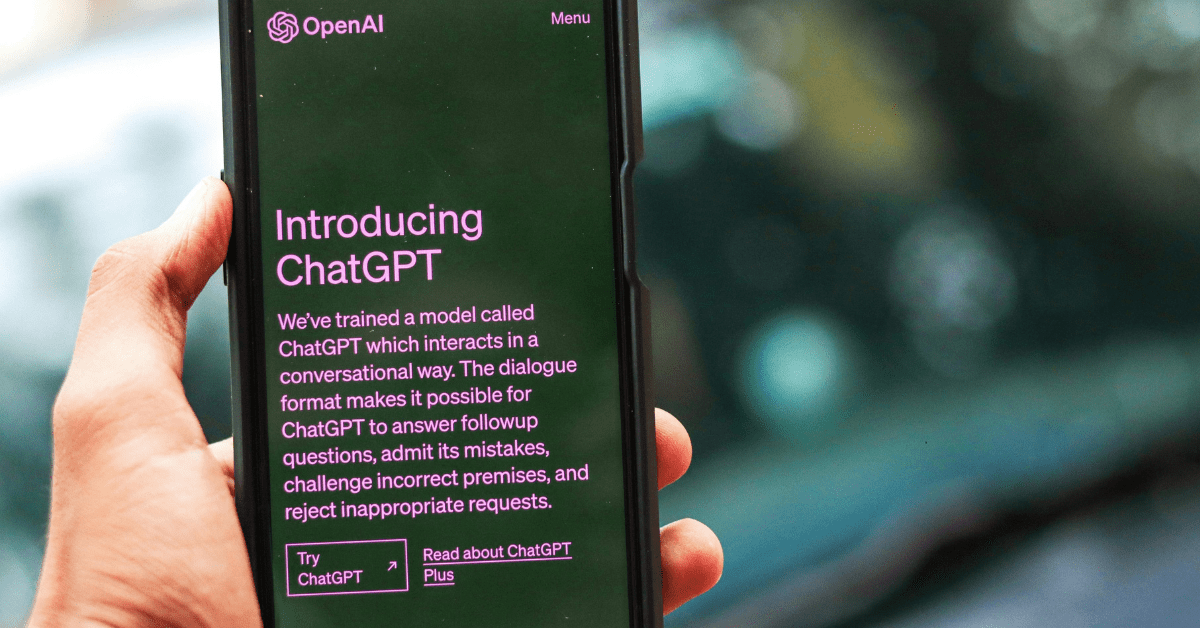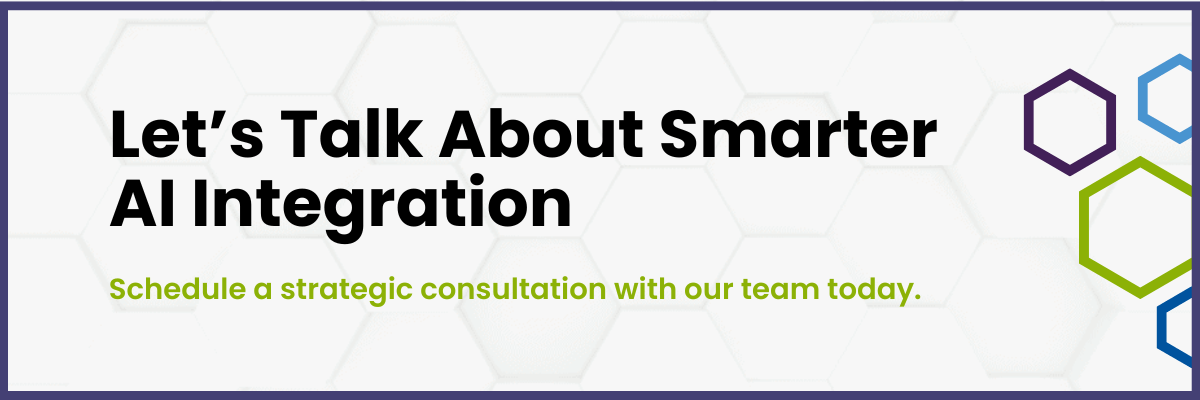Your marketing manager uses ChatGPT to create content for a client proposal, unknowingly feeding proprietary information into a public AI system. Your sales director asks Gemini to analyze customer information, accidentally exposing sensitive details to external platforms. Your accounting team relies on free tools to process financial data, not realizing that data might be used to train future models.
Scenarios like these are happening daily in businesses across America. While AI tools promise incredible productivity gains, the gap between potential and reality often comes down to one critical factor: proper employee AI training.
Today, we’re exploring the importance of clear guidance on AI use and how to create a policy that works for your business.
Why Wishful Thinking Isn’t a Good AI Strategy
AI undoubtedly has huge transformative potential. It’s dominated business conversations both on and offline for the past few years, and adoption only seems to be ramping up. This unprecedented level of buzz—and the relentless pressure to not be “left behind”—makes it incredibly easy to fall into a “figure it out as you go” mentality.
When business owners take this hands-off approach, the problems quickly multiply.
Security Risks
Without structured AI training for businesses, employees default to the most accessible tools—typically free, public-facing AI platforms that offer convenience at the cost of data security.
These tools often use input data to improve their systems, and as Anderson Technologies’ CTO, Luke Bragg, explains, “The public-facing, free versions of things like ChatGPT and Gemini are using that data to train their systems, and you have no control over what they do with it.”
Read more about verifying tools that look too good to be true.
Efficiency Impacts
Without standardized usage policies, teams tend to develop inconsistent workflows that incorporate different AI tools. Rather than improving efficiency as intended, this creates information silos and compatibility issues.
Shadow Tools
Most concerning is the emergence of “shadow AI”—unauthorized tool usage that happens without oversight or security protocols. When employees lack official guidance on using AI in business contexts, they inevitably start experimenting with tools you may have never heard of, entirely without your knowledge.
The resulting security risks go unaddressed because no one even realizes they exist.
Building Effective AI Integration Strategies
Successful AI adoption will require your business to move beyond ad hoc experimentation toward systematic implementation. This starts with understanding where AI can genuinely enhance your existing workflows.
Step 1: Where Can AI Assist Your Team?
Start by identifying repetitive tasks that consume significant time but don’t require deep human judgment.
Natural starting points for AI integration include:
- Document creation
- Data analysis
- Customer service responses
- Scheduling coordination
The key here is choosing applications where AI augments human capabilities rather than replacing critical thinking.
See the best ways to use AI in financial services.
Step 2: How Will You Choose Suitable AI Tools?
Different business functions require different approaches—free-to-use AI solutions might work well for general research tasks, but for sensitive financial or customer data, you’ll want to choose paid-for, enterprise-level plans with robust privacy protections.
Tools like Microsoft Copilot, which have security policies tied to your business agreement with Microsoft, tend to offer the most transparency around how your data will be used. Since Copilot only has access to internal items, it operates within your existing data permissions and privacy controls rather than exposing information to external training systems.
Additionally, you’ll need to consider what level of technical expertise the staff who’ll be using any new tools possess. Some AI solutions are far more user-friendly than others.
Step 3: Show Your Team How to Use Their New Tools
Create standardized workflows that demonstrate how any new AI tools integrate with your existing systems and processes. For adoption to be successful, your employees need concrete examples of successful AI application within their specific roles, not theoretical discussions about AI’s general capabilities.
What’s the Best AI Training Strategy for Businesses?
For businesses, a comprehensive AI training strategy goes beyond showing employees how to use specific tools. You need to combine technical education with strategic thinking, helping teams understand not just what AI can do, but when and how to use it appropriately.
Start with AI Fundamentals
Effective training begins with foundational concepts that demystify the ‘magic’ of AI technology. Team members need to understand how AI works, what it can and cannot do, and why certain precautions matter for business security. This groundwork helps employees make informed decisions about AI usage instead of relying on assumptions or fears.
Department-Specific Training Modules
Marketing teams need different AI skills than accounting departments, and generic training sessions might fail to provide actionable guidance for specific roles. Successful programs develop targeted modules that address each department’s unique workflows and challenges.
Learn about Anderson Technologies’ tailored training sessions.
Hands-On Learning with Approved Tools
Implement practical learning experiences using the actual tools and systems your organization has approved. Theory-based training has limited value—your employees need practice with real scenarios they’ll encounter in their work environment.
This approach builds their confidence while ensuring teams stay within established security boundaries. It’s also a good way to test whether your on-paper policies translate to real-life usage.
Ongoing Education and Updates
Establish continuous learning programs rather than one-time training events. AI technology evolves rapidly, and new tools emerge regularly. OpenAI, Google, Anthropic, and Meta all released major new models in 2024 alone.
Your team’s AI knowledge needs regular updates to remain relevant and secure. Quarterly refresher sessions and monthly tool updates help maintain competency levels across the organization.
Essential AI Guardrails Every Business Needs
Even with training in place, reducing AI risks requires everyday protective measures that prevent both intentional misuse and accidental violations. These four guardrails form the foundation of responsible AI usage and should be easy for your employees to review whenever needed:
- Tool Approval Lists: Maintain a whitelist of approved AI platforms and clearly communicate which tools are off-limits for business use. This prevents employees from defaulting to convenient but insecure options when they need AI assistance.
- Data Classification Protocols: Help employees recognize sensitive information before it gets shared with AI systems. Customer data, financial records, proprietary processes, and strategic planning documents need clear labeling and handling procedures.
- New Tool Evaluation Process: Create structured pathways for employees to request assessment of promising AI tools rather than adopting them independently. This encourages innovation while maintaining security oversight.
- Usage Monitoring and Audits: Track AI usage patterns across the organization to identify potential risk areas and policy violations. Regular reviews will reveal training gaps and highlight areas where guidelines might need strengthening.
Make AI Work for Your Organization
The businesses that thrive with AI are those that invest in proper preparation rather than hoping enthusiasm alone will drive success. Comprehensive training programs, clear policies, and professional support create the foundation for sustainable AI adoption that enhances productivity while managing risks effectively.
Treat AI implementation as a strategic initiative that deserves the same careful planning and resource allocation as any other significant business system. When done properly, AI becomes a powerful competitive advantage that transforms how work gets done while protecting the assets and relationships that matter most to your organization.
Need Help Training Your Team or Drafting Your AI Policy?
Talk to the Anderson Technologies team today.



